Value Chain and Trend Analysis of Agricultural Development in Ethiopia
| Received 29 Aug, 2023 |
Accepted 04 Nov, 2023 |
Published 10 Nov, 2023 |
Background and Objective: Ethiopia has immense potential for agricultural production. Continued efforts have been made by the government to improve the performance of agricultural production through agriculture and rural development policies and strategies. This research project aims to analyze the current trend and value chain of Ethiopian agriculture and rural development in the country. Materials and Methods: The research was undertaken through a literature review approach. The reviewed literature was thematically collected, summarized, analyzed, interpreted, narrated and then discussed. The studied factors regarding agricultural systems are credit, climate change, land degradation and deforestation, lack of integration, lack of irrigation facilities, sudden outbreaks of natural disasters, pests and shortage of technological advancement. Results: Insufficient access to credit, climate change, land degradation and deforestation, lack of integration, lack of irrigation facilities, sudden outbreaks of natural disasters, pests, shortage of technological advancement and narrow market support are the major constraints in agricultural production and productivity. In this regard, the use of improved seeds is at a very low level and the informal seed system is dominant in the country. Moreover, not all accessible seeds were reasonable for the soil and climate types inside and over the rural communities. On the other hand, few households in all the farming sites found the prevailing price of fertilizer expensive and tough to afford, partly due to restricted access to money. Those that may afford fertilizers were additionally involved concerning the danger of low profitableness given the high price on the one hand and on the other, erratic climatic conditions that could lead to low outputs. Conclusion: In general, poor farmers who constitute most of the Ethiopian farming community appear to be largely excluded from the input supply system-including seeds and fertilizer as well as credit and financial services. To eradicate and minimize the problems faced in the country’s agriculture it is recommended to establish a strong and dynamic result-based monitoring and evaluation system, investing more in agricultural research, development of infrastructure like access to roads and mechanization of the practice is needed.
| Copyright © 2023 Keba and Mohammed. This is an open-access article distributed under the Creative Commons Attribution License, which permits unrestricted use, distribution, and reproduction in any medium, provided the original work is properly cited. |
INTRODUCTION
Ethiopia is one of the largest country in Africa both in terms of land area (1.14 million sq km) and human population (102 million)1. Agriculture is the life-blood of the Ethiopian economy. The sector contributes 32.5% to the GDP, 72.7% to employment opportunities and 90% to raw materials for manufacturing industries1,2. Agriculture underpins the livelihoods of more than 17 million smallholder households who depend primarily on the rain-fed production of food crops3. The sector is in a great challenge to feed the ever-growing population. No sector in Ethiopia feels the pressure more dramatically than agriculture, which will expect to feed more people than at present. Hence, transforming a country’s agriculture sector like Ethiopia can help alleviate poverty and improve household food security, as well as increase incomes, create jobs and jump-start the overall economy4,5.
Ethiopia has monstrous potential for rural generation since the nation has endless zones of ripe arrive, broadened agro-ecologies reasonable for developing different sorts of crops and raising distinctive animal sorts and an expansive labor pool. Despite this contribution and potential, however, Ethiopian agriculture has remained underdeveloped. Domestic agricultural production has not grown in parallel with the population growth and failed to meet the food requirements of the country. It is the most volatile sector, as exhibited in the unevenness of its growth patterns, which is the effect of its heavy dependence on rainfall and the seasonal shocks that are frequently observed in Ethiopia.
Efforts have been made by the Government of Ethiopia (GoE) to improve the performance of agriculture through agriculture and rural development policies and strategies. The GoE is highly committed to sustainably increasing agricultural production and productivity to meet the growing demand for food, industrial raw materials and foreign currency earnings. Moreover, the combination of GoE, donors and financial institutions provides the framework to drive continued growth in the agriculture sector. Ethiopia has also signed the country-level.
The Comprehensive African Agricultural Development Programme (CAADP) compact is currently developing a PIF to align the financing commitments of the country’s development partners with GoE and the compact’s strategic plan.
This research project aims at analyzing the current situation of Ethiopian agriculture and rural development. The specific objectives of this study were:
• |
Analyze current situations in Ethiopia regarding agriculture, livestock, forestry and rural societies and their public development strategies and plans |
|
• |
To analyze the trend of agricultural growth in Ethiopia |
MATERIALS AND METHODS
Study area: The research was undertaken through a literature review approach. This review involves a qualitative and quantitative analysis of the current state of agriculture and rural development and agricultural value chain analysis in Ethiopia. The research has indeed employed an intensive review of various literatures including government policy and strategy documents, official reports, peer-reviewed articles, books, proceedings and conference papers that were previously published as the sources of the findings. The reviewed literature was thematically collected, summarized, analyzed, interpreted, narrated and then discussed. The study was carried out from June to July, 2022.
Different authors and researchers have written on the issues of agriculture, agriculture and rural development, agricultural policy and strategy, the performance of the agriculture sector, agricultural value chain analysis and challenges of Ethiopian agriculture. Many governmental and non-governmental organizations and agencies have produced reports on the situation of agriculture in Ethiopia. Among all these, those recent sources have been used to assess the current state of agriculture and rural development, agricultural value chain analysis and the challenges of agriculture and rural development in Ethiopia.
Current state of agricultural development in Ethiopia
Overview and current development of agriculture and rural areas in Ethiopia: The GoE has embarked on a 10 year economic development plan (2021-2030), in which agriculture is the top priority sector. The agricultural sector is expected to grow 6.2% per year over the next 10 years. Ethiopia's development plan has made improving agricultural production and productivity one of its key strategic pillars. The GoE has identified priority areas of intervention to increase the productivity of small farmers and expand large-scale commercial activities. In addition, the 10 year development plan aims to increase income from agricultural exports and replace imports by reducing production costs. To achieve this, the Egyptian Government seeks to promote the development of huge areas of unused arable land, modernize production systems and improve technology adoption. Additionally, the 10 year plan envisions building a green economy that is resilient to climate change. In this regard, Ethiopia continues to strengthen development efforts to combat land degradation and reduce pollution; reduce Greenhouse Gas (GHG) emissions; strengthen forest protection and development; increase electricity production from renewable energy sources for domestic use and export; and focus on modern, energy-saving technologies.
Moreover, efforts have been made by the GoE to improve the performance of the agricultural sector. The government has demonstrated a strong commitment to agriculture and rural development6. Moreover, Ethiopia has one of the largest frontline DA-to-farmer ratios in the world1. In addition to these, the country established more than 12,500 farmers training centers (FTCs) located across the national regional states of the country6.
Despite the revitalized focus on agriculture, the performance of agriculture was not satisfactory as poverty and food insecurity continue to be important features of the country. The agriculture sector has not been performing well to the extent that the country could not sufficiently feed its people from domestic production. Moreover, the aggregate rates and intensities of adoption of improved technologies remain low compared to those realized in Asia’s Green Revolution. Moreover, about one-fourth of the population lives below the national poverty line and is unable to attain the daily energy requirements of 2,100 Kcal/ADE/day5.
Agricultural research and extension development in Ethiopia: Ethiopia’s Government is persuaded that an effective and efficient agricultural research and extension system is essential for transforming smallholder subsistence agriculture into a commercial agricultural production system by generating and promoting the adoption of agricultural technologies that increase yield and quality. Ethiopia’s extension system has a lot of potential for supporting farmers all over the country. So far, over 83,000 DAs have been educated and graduated, with about 56,000 employed in the agricultural extension system6. The government has also built nearly 12,500 FTCs that operate at various levels. Furthermore, the government established 25 Agricultural Technical, Vocational and Educational Training (ATVET) colleges to train development agents (DAs) in various fields of expertise. On the other hand, the agricultural extension system faces a variety of obstacles, despite the state’s commitments. The majority of these issues have persisted from one government to the next and year to year7. Several factors, including government expenditures in the sector, especially on extension services, road networks, lower levels of rural education and lack of favorable domestic and foreign price incentives have influenced the wider circulation of improved technologies.
In terms of services delivered, Ethiopia’s agricultural extension system remains largely public and unimodal. It occurs within a dynamic government bureaucratic system that includes a variety of interactions, as well as the unique characteristics of the agriculture sector. A robust and vibrant extension system is a vital policy tool for bringing about necessary behavioral and attitude improvements, as well as putting pressure on national agricultural extension programs6. Agriculture extension services are important for encouraging the adoption of more productive farm technologies. Development experts have stressed the importance of it in achieving agricultural development, poverty reduction and food security. It is also important in the transformation of rural areas.
The agricultural research system in Ethiopia did not take off at once, rather its organizational capacity and processes evolved. The formal history of agricultural research is traced back to the establishment of Ambo Agricultural School in 1947, Jimma Agricultural Technical School (now Jimma University) in 1952 and the Imperial College of Agriculture and Mechanical Arts (now Haramaya University) in 1953. They emphasized the triangular functions of teaching, research and extension designed in the United States of America, Land Grant University archetype8. A separate institution responsible for agricultural research started following the establishment of the Institute of Agricultural Research (IAR) in 1966. Since the establishment of IAR, the Ethiopian National Agricultural Research System (NARS) has undergone several changes in its structural setup.
The research system underwent significant reforms in the early 1990s following the declaration of a decentralized political system in the country. The NARS was designed in advance to include the federal research institute, regional agricultural research institutes and higher education institute (HLI) agricultural research enterprises. In 1993, a number of IRA research centers were transferred to the regional government and became independent research centers. With the decentralization of the research system and the emergence of different stakeholders, the need to coordinate the research system across the country arose and this responsibility was assigned to the Ethiopian Agricultural Research Organization (EARO) while conducting research of national importance. In 1997, EARO was established as a new organization under proclamation No. 79/1997 and later on 25 October, 2005 the organization was renamed Ethiopian Institute of Agricultural Research (EIAR). Although, EIAR was tasked with coordinating regional and federal research institutes, there was no administrative control over regional research institutes and thus poor coordination between NARS became apparent clear. As a result, the Ethiopian Agricultural Research Council Secretariat (EARCS) was established in March, 2016, poised to take on the national coordination role for NARS.
RESULTS AND DISCUSSION
Importance of the agriculture sector
Contribution of agriculture to the national economy: The overall economy of the country is heavily dependent on agriculture as the main source of livelihood, employment, saving and earning of foreign currency and supplies of raw material requirements for manufacturing industries. Agriculture has played and continues to play a fundamental role in the government's policy and development strategies. It is unlikely, even unrealistic; to assume that there could be successful development of industrial and service sectors without effective interactions and transformation of the agriculture sector. The overall economic growth of the country and the fight against poverty would depend on the gains or losses of the agricultural sector. The sector can contribute not only to reducing poverty and increasing incomes but also generate jobs, export earnings and kick-start the overall economy of the country4,9.
Agriculture is the lifeblood of the Ethiopian economy. Despite the share of agriculture in GDP declining to 32.5%, its contribution to GDP growth improved to 29% by 2020/21 compared to the preceding years. The service sector continued to dominate the economy in 2020/21 as its share in GDP stood at 39.6% and its contribution to the GDP growth was 38.8%. According to the National Bank of Ethiopia (NBE), the industrial sector constituted a 29.3% share of the total GDP and it contributed 33.6% to the overall GDP growth in 2020/21. Despite the share of agriculture in the total GDP declining in recent years, its GDP contribution has increased from 212.5 billion ETB in 2010/11 to 686.4 billion ETB in 2020/211.
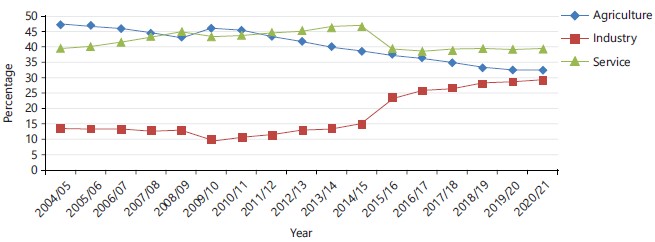
|
| Table 1: | Growth and percentage share of the agriculture sub-sectors | |||
| Rate | Sub-sectors |
2016/17 |
2017/18 |
2018/19 |
2019/20 |
2020/21 |
| Growth rate | Crop |
8.2 |
4.7 |
3 |
4.7 |
5.7 |
Animal farming |
4.2 |
0.6 |
6 |
3.3 |
5.8 |
|
Forestry |
3.6 |
3.5 |
3.8 |
3.9 |
3.9 |
|
Fishing |
0.5 |
11.3 |
2.3 |
2.8 |
1.7 |
|
| Share in agriculture | Crop |
64.5 |
65.3 |
64.8 |
65 |
65.1 |
Animal farming |
26.4 |
25.6 |
26.2 |
25.9 |
26 |
|
Forestry |
8.8 |
8.8 |
8.8 |
8.8 |
8.6 |
|
Fishing |
0.2 |
0.3 |
0.3 |
0.3 |
0.2 |
|
| Source1 | ||||||
It provides 72.7% of employment opportunities and 90% of raw materials for manufacturing industries. In addition, it is the major source of export revenue and accounts for 71.2% of the total value of exports in the country as presented in Fig. 11.
Agriculture grew by 5.5% in 2020/21, higher than the 4.3% growth recorded in the previous year mainly due to improvements in crop production, animal farming and hunting. Agriculture provides a living for about 17.7 million Ethiopian households4. The sector is still dominant in rural job opportunities, in serving as a base for industrial and service sector development, in serving as a major source of foreign currency earnings and in supplying economical raw materials for industry. Crop production had a lion’s share in agriculture accounting for 65.1% whereas animal farming and hunting accounted for 26%, forestry accounted for 8.6% and fishing accounted for 0.2% by 2020/21. In terms of growth, crop production expanded by 5.7%, animal farming and hunting (including fishery) and forestry registered 3.8 and 3.9% expansion, respectively by 2020/211.
Forests, as a sub-sector of agriculture, generate economic benefits in the form of cash and in-kind. The proportion of the forest sub-sector accounts for 8.6% in 2021. The contribution of forest ecosystems (including carbon sequestration, crop pollination, agricultural land conservation and control of water discharge into rivers and streams) to other sectors, especially agriculture, is highly appreciated at 6.77% of GDP. The fodder that herders get for free (by allowing their animals to graze on forest land) accounts for about 3.5% of GDP10. The added value of firewood is estimated at about 4.5% of GDP (Table 1)11.
Export revenues from agricultural commodities: Even with low agricultural productivity, Ethiopia’s economy is still largely dependent on agricultural commodities exported to earn foreign currency. Agriculture is the major source of export revenue in Ethiopia including coffee, oil seeds, pulses, flowers, chat, fruits and vegetables, meat and meat products, etc. Total merchandise export in 2020/21 amounted to USD 3.6 billion showing a 21.1% annual growth owing to higher export earnings from agricultural commodities. Despite an 8.3% decline in export volume, the gain in coffee export revenues, which total USD 909.4 million, was driven by a 15.9% increase in the commodity's worldwide price. However, coffee’s contribution to total merchandise export revenue fell from 28.6 to 25.1% from the previous year. Moreover, despite a 3.8% increase in export volume, revenue from oil seeds exports fell by 2.7% to USD 335.5 million due to the 6.3% drop in the world price. Not with standing a 25.6% increase in the international price of pulses, export volume fell by 20.7%, resulting in a minor loss in revenue of 0.4% and USD 233.8 million. As a result, its percentage of global merchandise exports fell from 7.9 to 6.5%. However, fruits and vegetables export revenues grew by 17.7% due to a 16.0% increase in export volume and a 1.5% increase in global prices. However, from a year earlier share of 2.0%, their share of all merchandise export receipts marginally decreased to 1.9% in 2020/21.
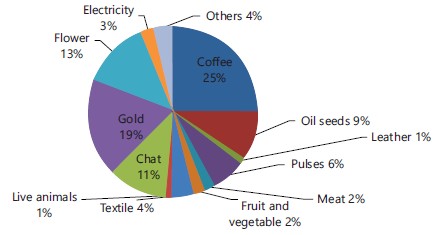
|
Receipts from meat and meat products export went up by 11.7% over last year wholly driven by a 14.1% increase in export volume despite a 2.1% drop in international price. However, their share in total export revenue constituted just 2.1%. Likewise, earnings from exports of leather and leather products recorded a 49.4% decline due to the fall in export volume (35.5%) and international price (21.5%). Consequently, the share of leather and leather products in total merchandise exports shrank to 1.0 from 2.4% last year as presented in Fig. 2.
Area, agricultural production and productivity trend in Ethiopia
Trends of crop land area in Ethiopia: In the 2020/21 cropping season, the total cropland area cultivated by major crops of the private peasant holdings was estimated to be 14,727,917.54 ha. Meher (main) season accounts for 12,979,459.91 ha (88.13%) and Belg season accounts for 1,748,457.63 ha (11.87%) of grain crops cultivated. Among the total cropland area, cereal production accounted for 80.62%, pulse accounted for 14.10% and oil seeds accounted for 5.28%. From the total cropland teff, maize, sorghum and wheat accounted for about 20, 22.2, 11.9 and 13.9% of the total crop area, in the same order. The trends of area allocation for cereal crops increased between 2009/10 and 2020/21, except barley, which reduced from 1129.112 to 926.107 thousand hectares as presented in Fig. 3.
Area allocation for pulse crops has been highly volatile since 2009/10. However, the trend of the area allocated for faba beans, field peas and lentils increased by 7,497.21, 6,604.98 and 21,444.41 ha, respectively between 2009/10-2020/21. However, the area allocated for haricot beans and chick peas reduced by 67,570.70 and 7,532.06 ha, respectively in the same period. Area allocation for soybeans is the lowest of all pulse crops. Between 2013/14 and 2017/18 area allocation for soybean is relatively stable; however, since 2018/19 it is increasing and reached 83,797 in 2020/21 from 5,679 ha in 2009/10 please see for the result on Fig. 4.
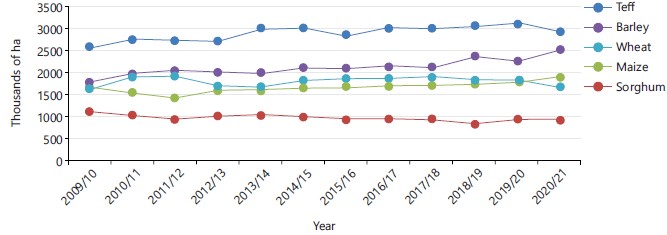
|

|
The trend indicates that smallholders’ total area allocations for oil seed decreased over the past 12 years, reducing from 780,916 to 766,168 ha. The area allocated for sesame was the highest of all other oil crops; however, the area increment for the crop was 17% over the past 12 years. Contrary to this the area allocated for neug was reduced between 2009/10 and 2020/21 by 25%. The area allocation for sunflowers is the lowest of the oil seed crops as shown in Fig. 5.
Agricultural production trend in Ethiopia: Agricultural crop production in Ethiopia increased from 110.4 million quintals in 2000/01 to 370.7 million quintals in 2020/21. Among the total production in 2020/21, cereals amounted to 314.2 million quintals, pulses 34.6 million quintals and oil crops amounted to 7.8 million quintals. Cereals including teff, maize, wheat, sorghum and barley are the most important crops for Ethiopian agriculture. Maize, teff, wheat and sorghum constituted 31.7, 15.2, 16.8 and 13% of the total grain production, respectively (Fig. 6).
According to the central statistical agency (CSA) data from smallholder farmers, cereal production in the main season has been an increasing trend between 2009/10 and 20120/21. Maize production is the highest of all cereal crops in the country which increased from 3.9 to 10.56 million metric tons (MT) (171% increment). The teff is the main staple food in Ethiopia, it increased from 3.18 million MT to 5.51 million MT (about 73% increment) in the same period. Similarly, wheat production increased in the decade from 3.08 to 5.78 million MT (about 88% increment). Despite the positive trends of wheat production over the past decade, it is unable to meet the ever-increasing demand for food and industrial raw materials, hence food insecurity, malnutrition and raw material shortage remain a challenge. Thus, the GoE has been importing the crop and dispersing it through subsidy (Fig. 7).

|
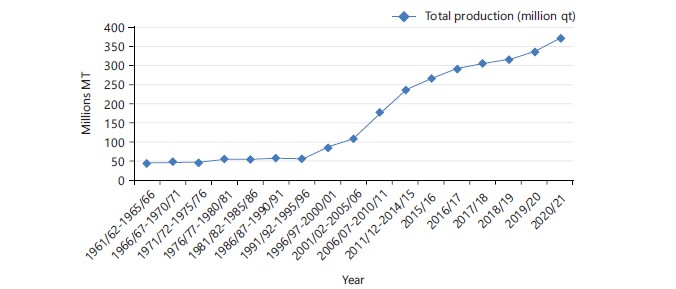
|
Between 2009/10 and 2020/21, except for lentils, the pulse production indicates increasing trends; the rates of production growth for faba bean, field peas, haricot beans, chickpeas and lentils were 65, 66, 34 and 53%, in the same order while lentil production was decreased by 4% due to newly infested diseases. Soybean production was the smallest of pulse production which was 15.824 thousand MT in 2010/11; it unexpectedly increased to 208.68 thousand MT in 2020/21 (964% increment) (Fig. 8).
Total oil seed production increased over the years between 2009/10 and 2020/21 by 21%, with neug and groundnut growth rates of 36 and 342% in the same years, however, linseed and sunflower decreased by 47 and 23%, espectively. Sesame and neug are competing in production for years. On average, 235,913.8 MT of neug and 253,832.1 MT of sesame were produced during the period; however, sesame was stagnant throughout the period. The lowest production among oil seeds was sunflower between the same years (Fig. 9).
Agricultural productivity trend in Ethiopia: Agricultural productivity growth in Ethiopia lags and the actual supply has not been sufficient for the demand of the population. Despite some improvements, agricultural productivity in Ethiopia remains low as compared to most Sub-Saharan African countries and the crop’s potential. For instance, the national average of agricultural productivity has increased from 7.3 quintals per hectare (qt ha–1) in 1961/62-1969/70s to about 24 qt ha–1 in 2020/21. Although, there is an increasing trend in agricultural productivity, there is a considerable yield gap between the current actual yields and the potential yields with improved technologies. Thus, it is important to exploit the opportunity to increase productivity through the widespread adoption of improved technologies that bring significant benefits to smallholders (Fig. 10).
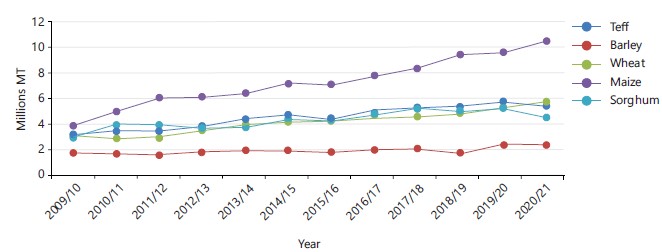
|
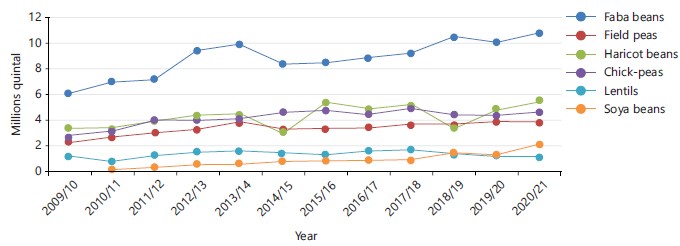
|
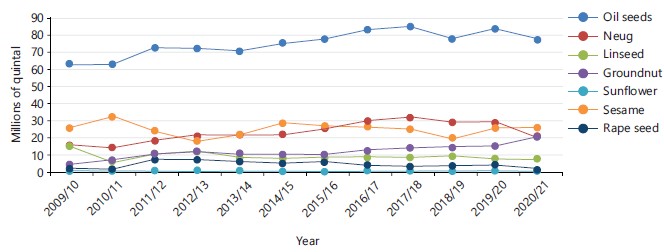
|
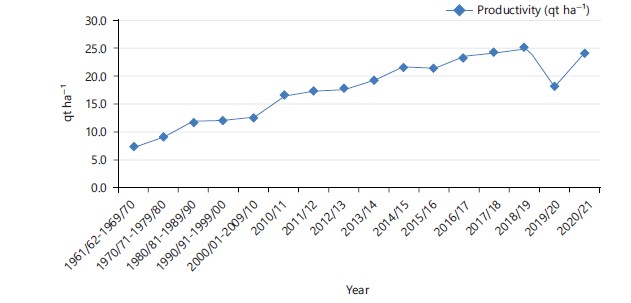
|
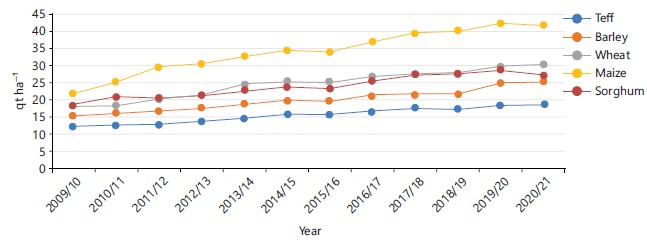
|
The yield of cereal crops shows an increasing trend. Maize gives the highest yield of other cereal crops which increased from 22 to 42 qt ha–1 between 2009/10 and 2020/21 which is below the potential of 50 qt ha–1 (EIAR unpublished document). The productivity of wheat and sorghum have been competing over the decade, however recently sorghum yield decreased while wheat yield increased. The teff gives the lowest yield (18.8 qt ha–1) compared to other cereal crops such as maize, sorghum, barley and wheat. However, the yield performance indicated an increasing trend, which increased from 12.3 to 18.8 qt ha–1 (35% increment) in the same period as presented in Fig. 11.
The yield level of the majority of pulse crops has increased over the years, but the increment of soybean was the highest of all pulse crops, which accounted for 25 qt ha–1 in 2020/2l. The yield increment between 2009/10 and 2020/21 was 77% for soy beans followed by faba beans (40%), field peas (36%), chick-pea (34%), lentils (28%) and haricot bean (24%). However, lentil yield decreased since 2018/19 due to the prevalence of the diseases presented in Fig. 12.
The yield performance of rape seed is the highest of all oil seeds that increased from 11 to 18 qt ha–1 over the years followed by groundnut with the same amount between 2009/10 and 2020/21. The productivity of neug also increased from 6 to 11 qt ha–1 recently, while the yield performance of sesame fluctuated and reduced from 8 qt ha–1 in 2009/10 to 7 qt ha–1 in 2020/21. Sesame has the lowest yield of all oil seeds presented in Fig. 13.
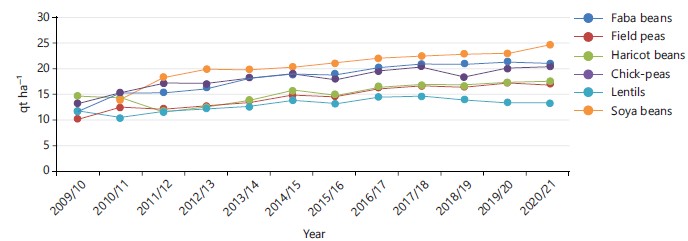
|
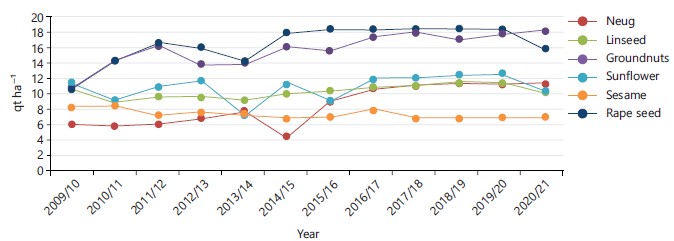
|
Livestock production trend in Ethiopia: Ethiopia has the largest livestock population in Africa, with 70.3 million cattle, 42.9 million sheep, 52.5 million goats, 8.2 million camels and 57 million poultry in 2020/21. Of the total cattle population, 98.24% are local breeds and the remaining are hybrid and exotic breeds. About 78.85% of poultry is indigenous and the rest are exotic (12.02%) and hybrid (9.11%). About 99.52% of the sheep and nearly all goat population of the country are local breeds. Despite the endogenous livestock population in Ethiopia holds the lion share of the total livestock population, the production of all livestock types increased between 2004/05 and 2020/21 (Fig. 14).
In terms of share of types of livestock population, cattle accounted for the highest share (30%) of the total number of livestock in Ethiopia, followed by poultry (25), goat (23), sheep (19) and camel (3%) in 2020/21.
National agriculture and rural development policies and strategies (with their strengths and weaknesses): Recognizing the importance and potential of this industry in the country’s overall economy, the Ethiopian Government has shown a strong commitment and introduced policies and strategies to promote the growth and development of the industry. Agricultural policies and strategies in Ethiopia aim to reduce poverty by improving farmers/herders’ access to and use of innovative technologies and practices to achieve growth, productivity and agricultural production. Ethiopia has undergone a series of policy, strategic and institutional changes in recent years aimed at improving the performance of its agricultural sector. However, political support for agriculture has varied across three major political regime changes in the country's recent history. Food crises and food insecurity have existed in Ethiopia for decades, are widespread and devastating and famine has claimed many lives under past regimes and now. To solve this problem, various agricultural development policies and strategies have been put into practice by successive regimes ruling the country, which in most cases have had a maximum impact. in solving bottlenecks in agriculture, stifling the country’s development12.

|
Among the various agricultural and rural development policies and strategies implemented by the government since 1991, the most important and long-term economic strategies to guide development efforts is directed industrialization. Agricultural development direction (ADLI), Sustainable Development and Poverty Reduction Program (SDPRP). Participatory and Accelerated Sustainable Development for Poverty Eradication (PASDEP) and sequential growth and transformation plans one and two (GTP I and II). These strategies aim to achieve food self-sufficiency at the national level by increasing the productivity of smallholders through research-generated information and technology, increasing the supply of cash crops and exports, while ensuring the restoration and conservation of the natural resource base with special attention to the package method7. In addition, during this time, the government abolished all subsidy and price support measures for agriculture. The structural adjustment program reduced the role of government and increased the role of supply and demand forces in resource allocation in the Ethiopian economy. All these policy interventions have been implemented to increase agricultural productivity and production, thereby reducing poverty and food insecurity.
Furthermore, the GoE has embarked on a ten-year economic development plan (2021-2030) which agriculture is the top priority sector. The agriculture sector is projected to grow at 6.2% per annum over the next ten years. Ethiopia’s development plan has laid out enhancing agricultural production and productivity as one of the major strategic pillars. In addition, the ten-year development plan aims at boosting agricultural export revenues and substituting imports by reducing production costs. To achieve this, the government seeks to leverage developing huge unutilized arable land, modernizing production systems and improving the uptake of technology. Furthermore, the ten-year plan envisages building a climate-resilient green economy. In this regard, Ethiopia is looking to expand development efforts to fight land degradation and reduce pollution; reduce GHG emissions; increase forest protection and development; increase production of electricity from renewable sources for domestic use and for export; and focus on modern and energy-saving technologies.
CONCLUSION AND RECOMMENDATIONS
Agriculture is one of the pillars of the Ethiopian economy and the country's overall economic growth depends heavily on the success of the agricultural sector. Therefore, the GoE demonstrates its strong commitment to improving the performance of the agricultural sector and sustainably increasing agricultural productivity and production to meet the growing demand for food, raw materials industry and foreign exchange earnings. Furthermore, under the ADLI strategy, the GoE has made huge efforts to transform the agriculture sector.
Although, efforts have been put in place to transform the agricultural sector, domestic agricultural food production has not met the domestic demand for food and the number of food insecure populations has increased over time. The agricultural sector is dominated by low-input, low-output and low-productivity rain-fed smallholder production. Rainfall is the chief determinant of Ethiopia’s economic performance. The dominance of agriculture has not changed over time mainly because of its poor performance in terms of generating a surplus that could be invested in other sectors of the economy. Fluctuations in food availability and consumption, caused by drought, crop failure and other factors, have increased the risk of consumption shortfall.
Moreover, limited land rights, inadequate access to water, insufficient access to credit, underdeveloped rural roads and transport infrastructures, shortage and landlessness of arable farmland in the highlands, climate change (droughts), land fragmentation, land degradation and deforestation, lack of integration, lack of irrigation facilities, sudden outbreaks of natural disasters, pests, political unrest, shortage of technological advancement, narrow market support, underprivileged agribusiness activities and under investment in research and extension are some of the major constraints in the agriculture sector of Ethiopia.
Furthermore, despite agricultural production in the value chain system being an important component, the agricultural value chain is complicated by substantial problems including low yield, poor quality supply, limited use of improved technologies, weak linkage among actors, lack of production and marketing skills, lack of capital, lack of market information, brokers hindering fairness in price, volatile pricing, the problem of rural road access, storage problems that lead to loses, improper shading, as well as weeds, diseases and pests.
Despite these encouraging initiatives, more needs to be done to improve the performance of agriculture and rural development and enhance the efficiency of value chains in the agricultural sector. Key among the initiatives aimed at improving performance are:
• |
Establish strong and dynamic result-based monitoring, evaluation and learning for continuous improvement of the performance of the agriculture sector |
|
• |
Investing more in agricultural R and D |
|
• |
Establish an appropriate institutional framework to strengthen agribusiness |
SIGNIFICANCE STATEMENT
The study discovered that analyzing the current trend and Value chain of Ethiopian agriculture and rural development in the country. Of all the extrinsic factors studied, the least satisfying to the staff was the salary structure and this calls for urgent attention because of the rate of inflation in Ethiopia. If the federal government of Ethiopia is sensitive to the welfare of the agricultural value chain in Ethiopia, this study will trigger the review of their welfare package. This will in turn institutional framework to strengthen agribusiness.
REFERENCES
- National Bank of Ethiopia, 2020. Annual Report of 2020/21. National Bank of Ethiopia, Addis Ababa, Ethiopia.
- FAO, 2019. Food Loss and Food Waste.
- Erenstein, O., M. Jaleta, K. Sonder, K. Mottaleb and B.M. Prasanna, 2022. Global maize production, consumption and trade: Trends and R&D implications. Food Sec., 14: 1295-1319.
- Teka, A. and S.K. Lee, 2020. Do agricultural package programs improve the welfare of rural people? evidence from smallholder farmers in Ethiopia. Agriculture, 10.
- FAO, 2016. Growth and Transformation Plan II (GTP II) (2015/16-2019/20).
- Zerssa, G., D. Feyssa, D.G. Kim and B. Eichler-Löbermann, 2021. Challenges of smallholder farming in Ethiopia and opportunities by adopting climate-smart agriculture. Agriculture, 11.
- Kebede, E., 2020. Grain legumes production and productivity in Ethiopian smallholder agricultural system, contribution to livelihoods and the way forward. Cogent Food Agric., 6.
- Ayele, Y., 2015. Policies and Practices of Consultation with Pastoralist Communities in Ethiopia: The Case of Omo-Kuraz Sugar Development Project. In: The Intricate Road to Development: Government Development Strategies in the Pastoral Areas of the Horn of Africa, Aberra, Y. and M. Abdulahi (Eds.), Institute for peace and security studies, Addis Ababa, Ethiopia, ISBN: 978-99944-962-7-3, pp: 274-297.
- Otchia, C.S., 2014. Agricultural modernization, structural change and pro-poor growth: Policy options for the Democratic Republic of Congo. J. Econ. Struct., 3.
- Cherinet, A. and T. Lemi, 2023. The role of forest ecosystems for carbon sequestration and poverty alleviation in Ethiopia. Int. J. For. Res., 2023.
- Befikadu, D., 2018. Postharvest losses in Ethiopia and opportunities for reduction: A review. Int. J. Sci.: Basic Appl. Res., 38: 249-262.
- Hailu, M., D. Tolosa, B. Kassa and A. Girma, 2020. Understanding factors affecting the performance of agricultural extension system in Ethiopia. Ethiop. J. Agric. Sci., 30: 237-263.
How to Cite this paper?
APA-7 Style
Keba,
A., Mohammed,
M.K. (2023). Value Chain and Trend Analysis of Agricultural Development in Ethiopia. Trends in Applied Sciences Research, 18(1), 201-214. https://doi.org/10.3923/tasr.2023.201.214
ACS Style
Keba,
A.; Mohammed,
M.K. Value Chain and Trend Analysis of Agricultural Development in Ethiopia. Trends Appl. Sci. Res 2023, 18, 201-214. https://doi.org/10.3923/tasr.2023.201.214
AMA Style
Keba
A, Mohammed
MK. Value Chain and Trend Analysis of Agricultural Development in Ethiopia. Trends in Applied Sciences Research. 2023; 18(1): 201-214. https://doi.org/10.3923/tasr.2023.201.214
Chicago/Turabian Style
Keba, Alemayehu, and Musba Kedir Mohammed.
2023. "Value Chain and Trend Analysis of Agricultural Development in Ethiopia" Trends in Applied Sciences Research 18, no. 1: 201-214. https://doi.org/10.3923/tasr.2023.201.214

This work is licensed under a Creative Commons Attribution 4.0 International License.


